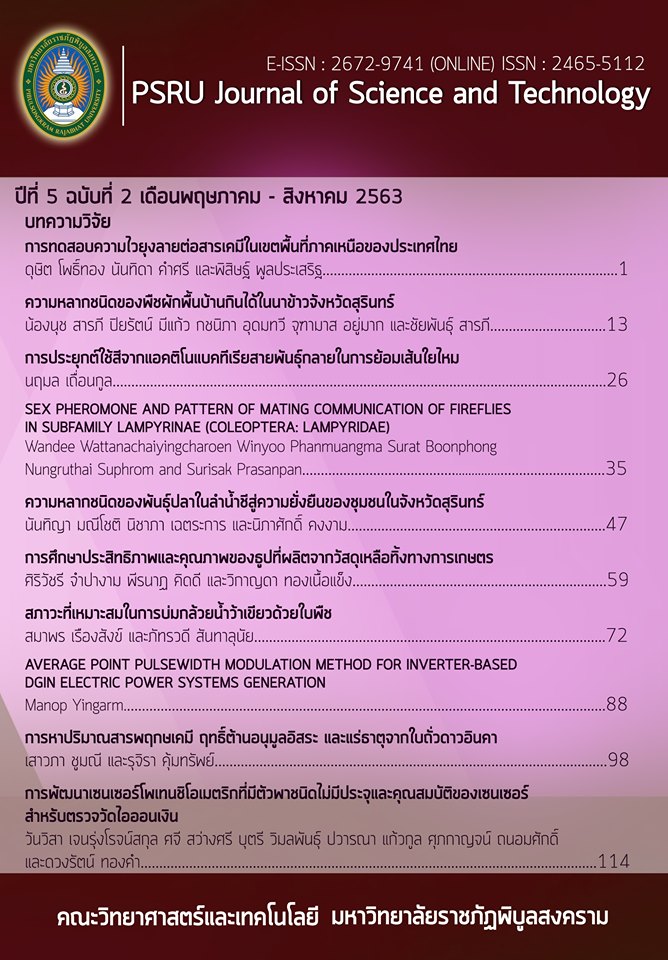SYNTHETIC INSECTICIDES SUSCEPTIBLE OF AEDES AEGYPTI IN THE AREAS OF LOWER NORTHERN PART OF THAILAND
Keywords:
Sensitivity, Aedes aegypti, Synthetic insecticidesAbstract
The objective of this study was to explore the sensitivity of Aedes aegypti to different synthetic insecticides. Mosquito larvae were gathered from main six districts within three main representative provinces Including Muang and Noen Maprang districts (Phitsanulok), Muang and Thung Saliam districts (Sukhothai) and Muang and Nam Pat districts (Uttaradit) in the lower northern part of Thailand. After all mosquitoes were bred and raised under the laboratory condition until becoming adults, susceptibility test according to the standard method of the World Health Organization was performed. It was revealed that Ae. aegypti obtained from every area demonstrated resistance to Alpha-cypermethrin 0.03%, Lambda-cyhalothrin 0.03%. Meanwhile, Ae. aegypti began to develop incipient resistance to Deltamethrin 0.15% in almost all areas except Ae. aegypti gathered from Muang Uttaradit that was susceptible to Deltamethrin 0.15% accounting for 100% of mortality rate. Based on the probit analysis (KT50 and KT95) after exposure, the mean KT50 and KT95 of Ae. aegypti exposed to Alpha-cypermethrin 0.03% were the lowest in Thung Saliam districts (Sukhothai) (69.20 minutes) and Noen Maprang (Phitsanulok) (109.99 minutes). For Lambda-cyhalothrin 0.03%, the mean KT50 and KT95 of Ae. aegypti were the lowest in Thung Saliam districts (Sukhothai) (69.30 minutes) and Muang (Uttaradit) (98.69 minutes). Whereas, Ae. aegypti gained from Nam Pat (Uttaradit) illustrated the lowest mean KT50 and KT95 of the treated mosquitoes (Deltamethrin 0.15%) of 22.31 and 51.64 minutes, respectively. Nonetheless, the use of chemicals should be considered when it is necessary and it should be correctly chosen according to academic principles. The sensitivity test of Aedes mosquitoes should be continuously performed. All obtained results could be the basic information for decision making to use chemicals safely and efficiently.
References
กาญจนา โกติทิพย์, เจนจิรา จันสุภา, สุธาสินี มาแดง, กานต์ธีรา เรืองเจริญ, และวรรณภา สุวรรณเกิด. (2561). ความไวของยุงลายบ้านต่อสารเคมีกลุ่มไพรีทรอยด์ในพื้นที่ 8 จังหวัดภาคเหนือ ปี 2558 และ 2559. วารสารสาธารณสุขล้านนา, 14(1), 13-22.
กองแก้ว ยะอูป, อาสาฬหะ พิมพ์บึง, บุญส่ง กุลโฮง, และพรทวีวัฒน์ ศูนย์จันทร์. (2554). ระดับความไวต่อ สารเคมีของลูกน้ำยุงลายและยุงลายในพื้นที่รับผิดชอบของสำนักงานป้องกันควบคุมโรคที่ 6 จังหวัดขอนแก่น ปี 2552. วารสารสำนักงานป้องกันควบคุมโรคที่ 6 ขอนแก่น, 18(3), 1-9.
กลุ่มพัฒนาวิชาการ สคร10 เชียงใหม่. (2556). ความไวของยุงลายบ้านอิจิปไตย์ต่อสารเคมีกำจัดแมลงพื้นที่ 8 จังหวัดภาคเหนือตอนบน ปีงบประมาณ 2555-2556 (รายงานวิจัย). เชียงใหม่: สำนักงานป้องกันควบคุมโรคที่ 10.
คณัจฉรีย์ ธานิสพงศ์, ขนิษฐา ปานแก้ว, และประชา สุขโชติ. (2554). ความไว/ความต้านทานสารเคมีกำจัดแมลงของยุงลายบ้านต่อสารเคมีกำจัดแมลงที่ใช้ในงานสาธารณสุข. วารสารโรคติดต่อนำโดยแมลง, 8, 28-43.
ทัศนีย์ เอกวานิช, ยุวดี ตรงต่อกิจ, และสุวิทย์ เพ็งพิศ. (2557). ความไวของยุงลายบ้านและยุงรำคาญต่อสาร Deltamethrin ในเขตเทศบาลนครภูเก็ต. วารสารวิชาการสาธารณสุข, 23(6), 1108-1114.
นิดา นันทกรปรีดา, สมฤทัย ในแสน, กีรติ ตันเรือน, พิสิษฐ์ พูลประเสริฐ, มนตรา ศรีษะแย้ม, ดุษิต โพธิ์ทอง, และยุวดี ตรงต่อกิจ. (2560). ฤทธิ์ฆ่าลูกน้ำยุงลายบ้าน (Aedes aegypti) ของสารสกัดเมล็ดน้อยหน่า (Annona squamosa) ที่หมักด้วยน้ำส้มควันไม้. PSRU Journal of Science and Technology, 2(3), 33-40.
ปิติ มงคลางกูร. (2559). คู่มือการใช้เครื่องพ่นสำหรับผู้ปฏิบัติการเพื่อป้องกันและควบคุมโรคไข้เลือดออก. นนทบุรี: กลุ่มงานกีฏวิทยาและควบคุมแมลงนำโรค สำนักโรคติดต่อนำโดยแมลง กรมควบคุมโรค กระทรวงสาธารณสุข.
เพ็ญนภา ชมะวิต, นฤมล โกมลมิศร์, และชำนาญ อภิวัฒนศร. (2555). การทดสอบความไวของยุงลายบ้านต่อสารเคมีกำจัดแมลง จังหวัดลพบุรี เพชรบุรี ปราจีนบุรี สุราษฎร์ธานี และกรุงเทพมหานคร. วารสารวิชาการสาธารณสุข, 20(3), 467-476.
วิชัย สติมัย. (2553). การศึกษาการใช้สารเคมีและความต้านทานของยุงพาหะต่อสารเคมีในภาคตะวันออกของประเทศไทย. วารสารโรคติดต่อนำโดยแมลง, 7(2), 18-30.
สุพรรณ สายหลักคำ, เจริญศักดิ์ แก้วหานาม, พรพิมล ขันภักดี, และศิริรัตน์ รักน้ำเที่ยง. (2559). การทดสอบความไวของลูกน้ำยุงลายต่อสารเคมีทีมีฟอสที่ระดับความเข้มข้น 0.02 มิลลิกรัมต่อลิตร จังหวัดเลยและหนองบัวลำภู ปี 2557. วารสารสำนักงานป้องกันควบคุมโรคที่ 7 จังหวัดขอนแก่น, 22(3), 38-45.
สำนักระบาดวิทยา. (2547). สรุปรายงานการเฝ้าระวังโรค ปี 2547 (รายงานประจำปี). นนทบุรี : องค์การรับส่งสินค้าและพัสดุภัณฑ์ กรมควบคุมโรค กระทรวงสาธารณสุข.
สำนักระบาดวิทยา. (2561). Number of cases, deaths, morbidity rate, mortality rate,casefatality rate, Thailand 2561. สืบค้นเมื่อ 5 ตุลาคม 2562, จาก http://www.boe.moph.go.th/boedb/surdata/disease.php?ds=262766
สำนักระบาดวิทยา. (2562). จำนวนผู้ป่วยและตายด้วยโรคไข้เลือดออก จำแนกรายเดือนตามวันเริ่มป่วย รายจังหวัด ประเทศไทย สัปดาห์ที่ 32 ปี 2562. สืบค้นเมื่อ 5 ตุลาคม 2562, จากhttp://www.boe.moph.go.th/boedb/surdata/disease.php?ds=262766
สำนักโรคติดต่อนำโดยแมลง กรมควบคุมโรค กระทรวงสาธารณสุข. (2557). คู่มือการทดสอบสารเคมี. นนทบุรี: ชุมนุมสหกรณ์การเกษตรแห่งประเทศไทย จำกัด กรมควบคุมโรค กระทรวงสาธารณสุข.
Abbott, W.S. (1925). Amethod for computing the effectiveness of an insecticide. Journal of Economic Entomology, 18, 265-267.
Becker, N., Petrić, D., Zgomba; M., Boase, C., Dahl, C., Lane, J. & Kaiser, A. (2003). Mosquitoes and their Control. New York: Kluwer Academic / Plenum Publishers.
Chandra, G., Bhattacharjee, I., Chatterjee, S.N. & Ghosh, A. (2008). Mosquito control by larvivorous fish. The Indian Journal of Medical Research, 27,13–27.
Deshpande, S.G. (2016). Renofluthrin: Novel pyrethroid insecticide mosquito coil for mosquito control. International Journal of Mosquito Research, 3(2), 1-3.
Finney, D.J. (1971). Probit analysis. London: Cambridge University Press.
Han, W.W., Lazaro, A., McCall, P.J., George, L., Runge-Ranzinger, S., … Toledo, J. (2015). Efficacy and community effectiveness of larvivorous fish for dengue vector control. Tropical Medicine and International Health, 20, 1239–1256.
Juntarajumnong, W., Pimnon, S. Bangs, M.J., Thanispong, K. & Chareonviriyaphap, T. (2012). Discriminating lethal concentrations and efficacy of six pyrethroids for control of Aedes aegypti in Thailand. Journal of the American Mosquito Control Association, 28(1), 30–37.
Sirisopa, P., Thanispong, K., Chareonviriyaphap, T & Juntarajumnong, W. (2014). Resistance to Synthetic Pyrethroids in Aedes aegypti (Diptera: Culicidae) in Thailand. Kasetsart Journal : Natural Science, 48, 577 – 586.
Tanruean, K., Napiroon, T., Phusing, S., Torres, J.R.D., Villanueva, P.M. & Poolprasert, P., (2019). Larvicidal effects of Paederia pilifera Hook.f. leaf and Cuscuta reflexa Roxb. stem extracts against the dengue vector mosquito Aedes aegypti Linn. The Journal of Applied Science, 18(1), 31-38.
Thongpoon C. & Poolprasert, P. (2015). Phytochemical screening and larvicidal activity of Millingtonia hortensis L.f. flower extract against Aedes aegypti Linn. Kasetsart Journal (Natural Science), 49(4), 597-605.
Walshe, D.P., Garner, P., Adeel, A.A., Pyke, G.H., & Burkot, T.R. (2017). Larvivorous fish for preventing malaria transmission. The Cochrane database of systematic reviews, 12(12), CD008090.
World Health Organization. (2016). Monitoring and managing insecticides resistance in Aedes mosquito populations. Switzerland: Geneva.
World Health Organization. (2011). Global insecticide use for vector-borne disease control: a 10 -year assessment (2000-2009). (5th ed.). Switzerland: Geneva.
Downloads
Published
How to Cite
Issue
Section
License
กองบรรณาธิการขอสงวนสิทธิ์ในการปรับปรุงแก้ไขตัวอักษรและคำสะกดต่างๆ ที่ไม่ถูกต้อง และต้นฉบับที่ได้รับการตีพิมพ์ในวารสาร PSRU Journal of Science and Technology ถือเป็นกรรมสิทธิ์ของคณะวิทยาศาสตร์และเทคโนโลยี มหาวิทยาลัยราชภัฏพิบูลสงคราม และ
ผลการพิจารณาคัดเลือกบทความตีพิมพ์ในวารสารให้ถือมติของกองบรรณาธิการเป็นที่สิ้นสุด







